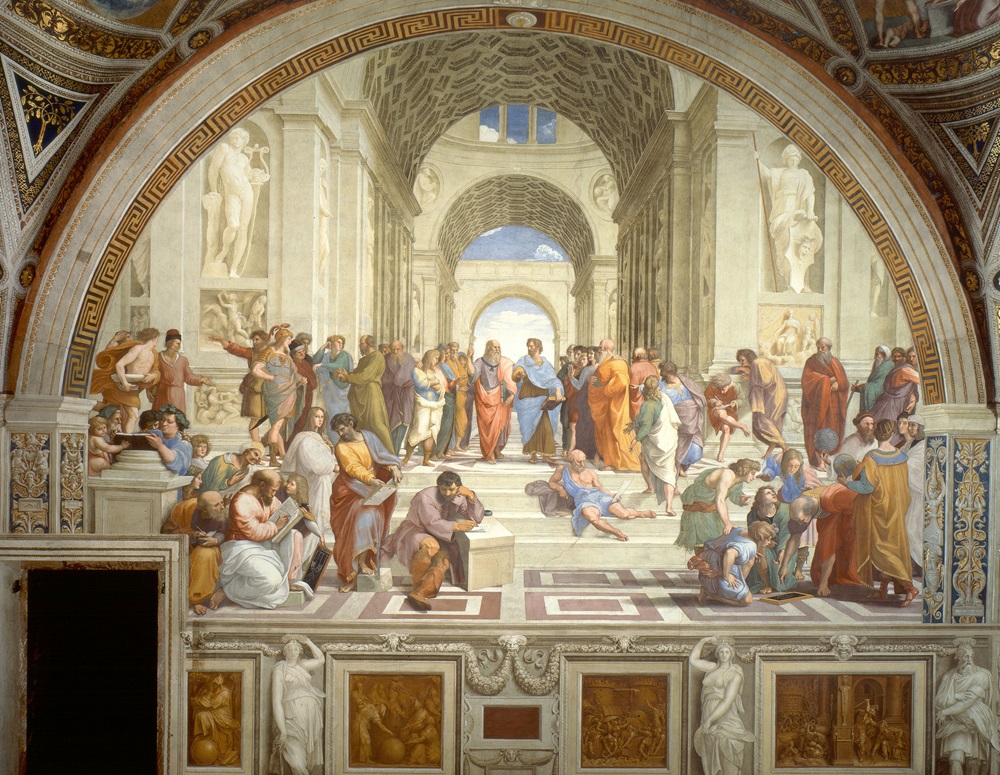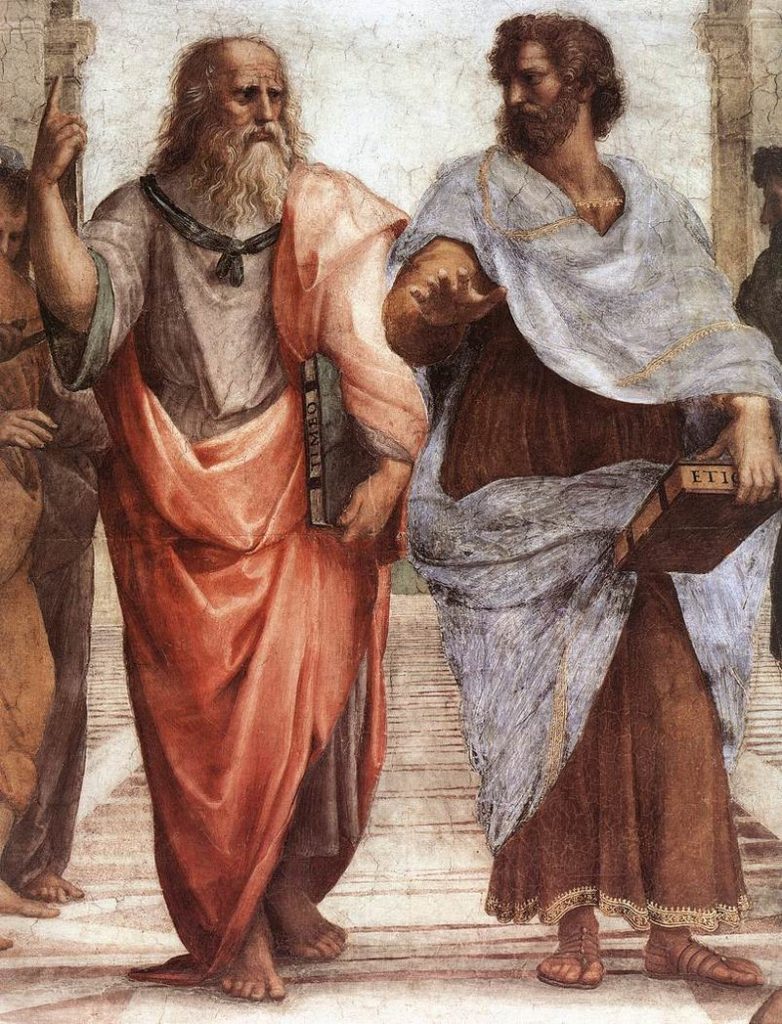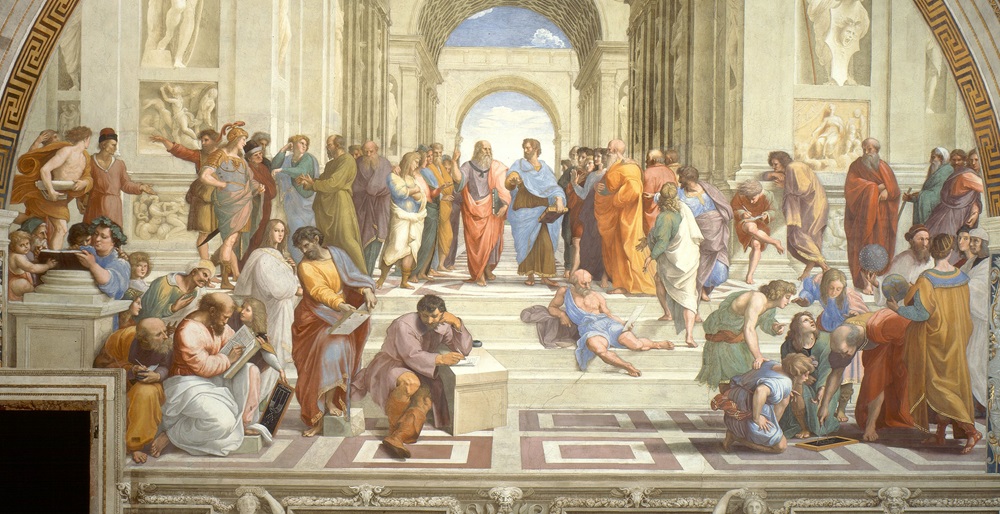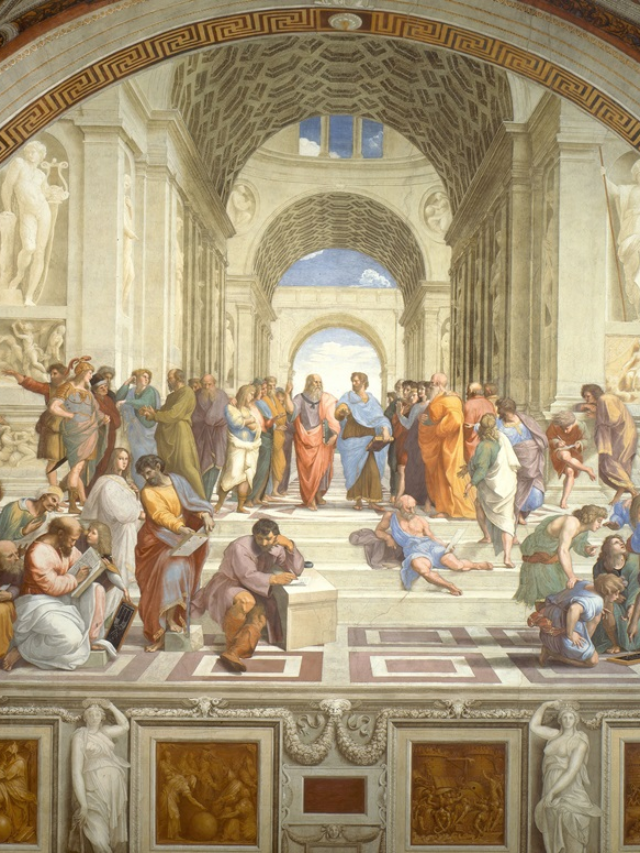a
How can an artist visually convey a thought process such as philosophy? Raphael chose to illustrate the diverse range of discursive and ratiocinative activities by numerous adult male philosophers in a magnificent tower on a sunny day in The School of Athens. The School of Athens, a well-known painting by Raphael, depicts a geometer—possibly Euclid himself—among the esteemed Greek intellectuals at work, explaining a building to his pupils.
The spectacular architectural space, grandeur, luxury, and sobriety are occupied by fifty-eight figures busily engaged in activities typical of philosophers in action: reading, writing, lecturing, disputing, demonstrating, questioning, listening, contemplating, appreciating, and doubting. This mysterious painting should be seen more like a live theatrical production, with the gestures, postures, costumes, and unspoken dialogues needing to be carefully interpreted within the framework of Raphael’s world rather than as a two-dimensional snapshot of well-known figures from the Renaissance and Antiquity.
This decision seems obvious because Raphael’s image is ingrained in our subconscious. The historical imagination must acknowledge that philosophy in the first ten years of the sixteenth century was only sometimes represented in this way, or even likely. The basic idea behind The School of Athens is unique in European art history.
Raphael and the High Renaissance
The three significant artists whose work characterises the Italian High Renaissance are Raphael (1483–1520), Leonardo da Vinci (1452-1519), and Michelangelo (1475–1564). Raphael was the youngest of these artists. Raphael, who was raised as an orphan after becoming the son of a small-time painter, studied under the renowned Perugino, famous for his delicate figures. By the time he was twenty-one, he had matched, if not exceeded, the skill of his mentor.
Raphael had access to substantial mathematics through his paintings and connections. Early Renaissance mathematics had just achieved a new victory when painting three-dimensional space as faithfully as possible thanks to the “scientific” perspective. Among Raphael’s most well-known creations are the frescoes he painted in the Vatican while working under Pope Julius II’s patronage. The “School of Athens,” a section of the Stanza della Segnatura, is the most well-known of these murals. Raphael portrayed a group of classical philosophers and intellectuals in this masterwork, including Plato and Aristotle. Raphael’s command of perspective, balance, and classical ideals is evident in the composition.
Raphael’s “Madonna and Child” series, in which he depicted the Virgin Mary and the infant Jesus in various compositions, is another noteworthy body of work. These paintings show his ability to portray elegance, beauty, and a sense of heavenly tranquillity.
At the age of 37, Raphael’s career came to an end in 1520. Despite having a brief life, he significantly influenced Renaissance painting, and his creations continued to impact painters for generations. Raphael’s contributions to the High Renaissance, distinguished by a flawless fusion of classical principles, technical proficiency, and an in-depth comprehension of human anatomy and emotion, define his legacy.

Raphael had extraordinary technical proficiency. His ability to create harmonious and balanced works set him apart, and his mastery of composition, perspective, and colour was much acclaimed. Many artists who followed in his footsteps regarded his work as the pinnacle of their craft. Raphael’s artwork exhibits a profound comprehension and integration of classical principles. He incorporated classical aspects into his works, drawing influence from the art of the ancient Greeks and Romans.
Raphael’s portraits are renowned for their empathy and capacity to capture the subjects’ essence and feelings. His artwork gained a humanistic touch from his astute observation of human nature and deft use of subtle expressions. Raphael had a lasting impact that went much beyond his life. His paintings inspired artists of later eras, such as the Mannerists and the Baroque painters. The fact that his work is still studied and appreciated shows how influential he was; many people view him as the height of artistic excellence.
School of Athens and the High Renaissance
One of Raphael’s most well-known pieces and a prime illustration of the High Renaissance is “School of Athens.” This painting, which was painted between 1509 and 1511, is housed at the Vatican Palace’s Stanza della Segnatura. The picture is a masterwork that perfectly captures the High Renaissance’s themes, aesthetics, and ideals.
A resurgence of interest in classical philosophy and painting defined the High Renaissance. The revival is portrayed visually in Raphael’s “School of Athens.” Plato and Aristotle are among the well-known thinkers and academics from classical Greece and Rome who are gathered in the picture together with other noteworthy individuals. The composition embodies the classical values of reason, knowledge, and the search for the truth. Humanism was a Renaissance critical intellectual movement that emphasised reading classic literature and applauding human accomplishment.
Raphael honours this humanistic spirit in the “School of Athens,” where he portrays the great minds of antiquity conversing and exchanging ideas. The emphasis on information acquisition and human intellect is consistent with the humanistic aspirations of the day. A prominent characteristic of the High Renaissance was achieving harmony and balance in creative creations. With the “School of Athens,” Raphael skillfully employs perspective, symmetry, and proportion. Placing the architectural and figure components creates a sense of balance and order, which adds to the composition’s overall visual harmony.

High Renaissance painters frequently aimed to capture the beauty of the human body by presenting idealised shapes. Raphael’s depictions of historical philosophers and idealised representations of wisdom and beauty can be seen in the “School of Athens.” The figures’ elegant stances and meticulous anatomy portray the Renaissance’s fascination with form perfection.
A master of perspective, Raphael’s work can be seen in the “School of Athens.” The observer is drawn into the painting’s space using linear perspective, which gives the image a sense of depth. This method highlighted the painters’ command of mathematics and capacity to produce lifelike illusions of three-dimensional space and was a defining characteristic of High Renaissance painting.
Plato and Aristotle
Plato and Aristotle are depicted at the centre, with Plato gesturing toward his ideals in heaven (gesturing down to the real world here on earth). Each man carries a prominent book that is appropriately marked, making their identities obvious. However, these are rarely necessary because Raphael has masterfully conveyed, only by their motions, the substance of the two great men’s ideologies in an easily readable style. Next, the image is cleanly split into the realists, represented by Aristotle, on the right, and the idealists, described by Plato, on the left. To Plato’s left, engaged in a heated debate, are Socrates and his followers (Phaedo, Crito, and in fancy armour, maybe Xenophon or Alcibiades).
Raphael’s “School of Athens,” with its combination of classical themes, humanistic aspirations, aesthetic balance, idealised beauty, and sophisticated perspective methods, perfectly captures the spirit of the High Renaissance. It serves as evidence of the artistic and intellectual prowess of the era.
Stone Giants of Mystery: Exploring the Intriguing World of Easter Island’s Moai Statues






